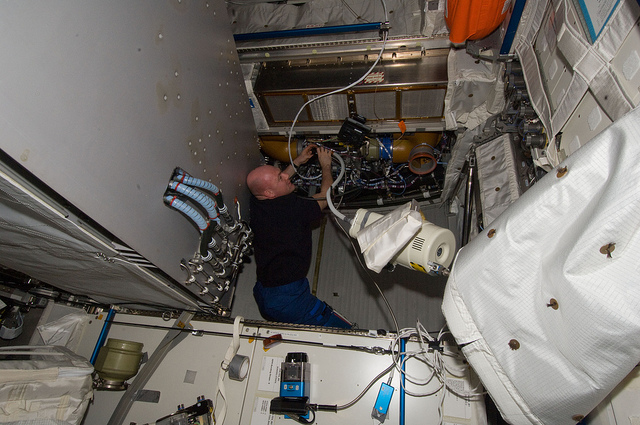Following our earlier post, ATV-4 mission report 23 August, a keen blog follower, Nicola, posted a query: Could you tell us more about O2 transfer vs. air transfer? Air as ‘normal air’ and some additional O2?
We passed this over to Mike Steinkopf at ATV-CC, who answered:
ATV can carry two different type of gas. One type in Gas tank 1 and a second type of gas in Gas tank 2 and 3 ( they are both connected). The gas tanks are qualified for three different types of gas: O2, Air and Nitrogen.

André Kuipers uses a vacuum cleaner on the Columbus ventilation systems (Credit: NASA)
Depending on the Station’s predicted needs, the tanks are filled before launch in Kourou. So far, for all ATV missions, the Station has requested O2 and Air.
The Oxygen (100% O2) is transferred in particular to increase the O2 partial pressure within the station, whereas Air (which contains ‘just’ 21% O2) is transferred to increase the overall pressure inside, e.g. after an EVA.
(During an EVA, there is always a small decrease in total pressure due to depressurization and repressurization of the airlock through which crew is leaving and returning. This is also true for arrival and departure of visiting vehicles.)
Basically, ISS pressure is kept at around 750 mmHg, so compared to us living on Earth, the astronauts are living slightly in the mountains and not at sea level (where the standard atmospheric pressure is 760 mmHg). Hope this answers the question! Best regards,
Mike J. Steinkopf
Mission Director
ESA ATV Operations Management Team
ATV-Control-Center Toulouse
—-
Thanks, Mike! Read more details on the ISS Environmental Control and Life Support System (ECLSS) from ESA’s Samantha Cristoforetti via the Astronaut Class of 2009 blog.

 Automated Transfer Vehicle page
Automated Transfer Vehicle page ATV blog archive
ATV blog archive
Discussion: no comments